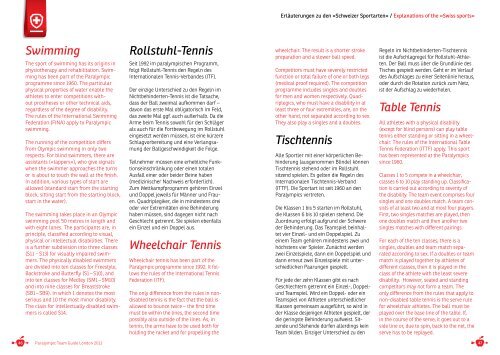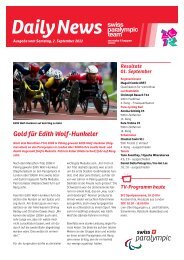Team Guide - Swiss paralympic committee
Team Guide - Swiss paralympic committee
Team Guide - Swiss paralympic committee
You also want an ePaper? Increase the reach of your titles
YUMPU automatically turns print PDFs into web optimized ePapers that Google loves.
Erläuterungen zu den «Schweizer Sportarten» / Explanations of the «<strong>Swiss</strong> sports»<br />
Swimming<br />
The sport of swimming has its origins in<br />
physiotherapy and rehabilitation. Swimming<br />
has been part of the Paralympic<br />
programme since 1960. The particular<br />
physical properties of water enable the<br />
athletes to enter competitions without<br />
prostheses or other technical aids,<br />
regardless of the degree of disability.<br />
The rules of the International Swimming<br />
Federation (FINA) apply to Paralympic<br />
swimming.<br />
The running of the competition differs<br />
from Olympic swimming in only two<br />
respects. For blind swimmers, there are<br />
assistants («tappers»), who give signals<br />
when the swimmer approaches the turns<br />
or is about to touch the wall at the finish.<br />
In addition, various types of start are<br />
allowed (standard start from the starting<br />
block, sitting start from the starting block,<br />
start in the water).<br />
The swimming takes place in an Olympic<br />
swimming pool 50 metres in length and<br />
with eight lanes. The participants are, in<br />
principle, classified according to visual,<br />
physical or intellectual disabilities. There<br />
is a further subdivision into three classes<br />
(S11 - S13) for visually impaired swimmers.<br />
The physically disabled swimmers<br />
are divided into ten classes for Freestyle,<br />
Backstroke and Butterfly (S1 – S10), and<br />
into ten classes for Medley (SM1 – SM10)<br />
and into nine classes for Breaststroke<br />
(SB1 – SB9). In which 1 denotes the most<br />
serious and 10 the most minor disability.<br />
The class for intellectually disabled swimmers<br />
is called S14.<br />
Rollstuhl-Tennis<br />
Seit 1992 im paralympischen Programm,<br />
folgt Rollstuhl-Tennis den Regeln des<br />
Internationalen Tennis-Verbandes (ITF).<br />
Der einzige Unterschied zu den Regeln im<br />
Nichtbehinderten-Tennis ist die Tatsache,<br />
dass der Ball zweimal aufkommen darf –<br />
davon das erste Mal obligatorisch im Feld,<br />
das zweite Mal ggf. auch außerhalb. Da die<br />
Arme beim Tennis sowohl für den Schläger<br />
als auch für die Fortbewegung im Rollstuhl<br />
eingesetzt werden müssen, ist eine kürzere<br />
Schlagvorbereitung und eine Verlangsamung<br />
der Ballgeschwindigkeit die Folge.<br />
Teilnehmer müssen eine erhebliche Funktionseinschränkung<br />
oder einen totalen<br />
Ausfall einer oder beider Beine haben<br />
(medizinischer Nachweis erforderlich).<br />
Zum Wettkampfprogramm gehören Einzel<br />
und Doppel jeweils für Männer und Frauen.<br />
Quadriplegiker, die in mindestens drei<br />
oder vier Extremitäten eine Behinderung<br />
haben müssen, sind dagegen nicht nach<br />
Geschlecht getrennt. Sie spielen ebenfalls<br />
ein Einzel und ein Doppel aus.<br />
Wheelchair Tennis<br />
Wheelchair tennis has been part of the<br />
Paralympic programme since 1992. It follows<br />
the rules of the International Tennis<br />
Federation (ITF).<br />
The only difference from the rules in nondisabled<br />
tennis is the fact that the ball is<br />
allowed to bounce twice – the first time<br />
must be within the lines, the second time<br />
possibly also outside of the lines. As, in<br />
tennis, the arms have to be used both for<br />
holding the racket and for propelling the<br />
wheelchair. The result is a shorter stroke<br />
preparation and a slower ball speed.<br />
Competitors must have severely restricted<br />
function or total failure of one or both legs<br />
(medical proof required). The competition<br />
programme includes singles and doubles<br />
for men and women respectively. Quadriplegics,<br />
who must have a disability in at<br />
least three or four extremities, are, on the<br />
other hand, not separated according to sex.<br />
They also play a singles and a doubles.<br />
Tischtennis<br />
Alle Sportler mit einer körperlichen Behinderung<br />
(ausgenommen Blinde) können<br />
Tischtennis stehend oder im Rollstuhl<br />
sitzend spielen. Es gelten die Regeln des<br />
Internationalen Tischtennis-Verband<br />
(ITTF). Die Sportart ist seit 1960 an den<br />
Paralympics vertreten.<br />
Die Klassen 1 bis 5 starten im Rollstuhl,<br />
die Klassen 6 bis 10 spielen stehend. Die<br />
Zuordnung erfolgt aufgrund der Schwere<br />
der Behinderung. Das <strong>Team</strong>spiel beinhaltet<br />
vier Einzel- und ein Doppelspiel. Zu<br />
einem <strong>Team</strong> gehören mindestens zwei und<br />
höchstens vier Spieler. Zunächst werden<br />
zwei Einzelspiele, dann ein Doppelspiel und<br />
dann erneut zwei Einzelspiele mit unterschiedlichen<br />
Paarungen gespielt.<br />
Für jede der zehn Klassen gibt es nach<br />
Geschlechtern getrennt ein Einzel-, Doppelund<br />
<strong>Team</strong>spiel. Wird ein Doppel- oder ein<br />
<strong>Team</strong>spiel von Athleten unterschiedlicher<br />
Klassen gemeinsam ausgeführt, so wird in<br />
der Klasse desjenigen Athleten gespielt, der<br />
die geringste Behinderung aufweist. Sitzende<br />
und Stehende dürfen allerdings kein<br />
<strong>Team</strong> bilden. Einziger Unterschied zu den<br />
Regeln im Nichtbehinderten-Tischtennis<br />
ist die Aufschlagregel für Rollstuhl-Athleten.<br />
Der Ball muss über die Grundlinie des<br />
Tisches gespielt werden. Geht er im Verlauf<br />
des Aufschlages zu einer Seitenlinie heraus,<br />
oder durch die Rotation zurück zum Netz,<br />
ist der Aufschlag zu wiederholen.<br />
Table Tennis<br />
All athletes with a physical disability<br />
(except for blind persons) can play table<br />
tennis either standing or sitting in a wheelchair.<br />
The rules of the International Table<br />
Tennis Federation (ITTF) apply. This sport<br />
has been represented at the Paralympics<br />
since 1960.<br />
Classes 1 to 5 compete in a wheelchair,<br />
classes 6 to 10 play standing up. Classification<br />
is carried out according to severity of<br />
the disability. The team event comprises four<br />
singles and one doubles match. A team consists<br />
of at least two and at most four players.<br />
First, two singles matches are played, then<br />
one doubles match and then another two<br />
singles matches with different pairings.<br />
For each of the ten classes, there is a<br />
singles, doubles and team match separated<br />
according to sex. If a doubles or team<br />
match is played together by athletes of<br />
different classes, then it is played in the<br />
class of the athlete with the least severe<br />
disability. However, seated and standing<br />
competitors may not form a team. The<br />
only difference from the rules that apply to<br />
non-disabled table tennis is the serve rule<br />
for wheelchair athletes. The ball must be<br />
played over the base line of the table. If,<br />
in the course of the serve, it goes out to a<br />
side line or, due to spin, back to the net, the<br />
serve has to be replayed.<br />
46 Paralympic <strong>Team</strong> <strong>Guide</strong> London 2012<br />
47



